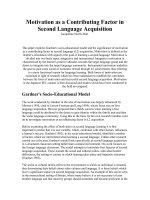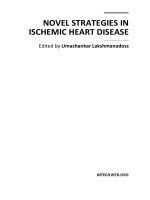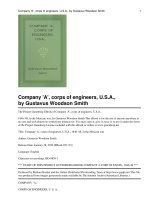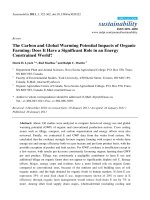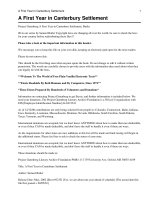Hydrogen sulfide, a cardioprotective agent in ischemic heart
Bạn đang xem bản rút gọn của tài liệu. Xem và tải ngay bản đầy đủ của tài liệu tại đây (3.83 MB, 145 trang )
HYDROGEN SULFIDE,
A CARDIOPROTECTIVE AGENT IN ISCHEMIC HEART
PAN TINGTING
(B.Sci., China Pharmaceutical University)
A THESIS SUBMITTED
FOR THE DEGREE OF DOCTOR OF PHILOSOPHY
DEPARTMENT OF PHARMACOLOGY
NATIONAL UNIVERSITY OF SINGAPORE
2008
ACKNOWLEDGEMENT
I would like to express my deepest gratitude to my supervisor, Dr. Bian Jinsong, who has
devoted tremendous efforts to guiding me throughout my research. Without his invaluable advice
and continuous support, I would not have progressed thus far. His optimism and perseverance at
times of difficulties also made huge impact on my scientific development and well beyond.
My sincere appreciation is extended to Mr. Feng Zhanning for his generous help with the
calcium recording work.
Special thanks to my colleagues, Yong Qian Chen, Ester Khin Sandar Win, Neo Kay Li, Hu
Lifang, Wu Zhiyuan and Lee Shiau Wei, who have always been ready to help over the 4 years.
I would also like to extend my deep gratitude to my family, and in particular, my husband for
giving me every possible encouragement and inspiring me to reach my full potential.
TABLE OF CONTENT
PUBLICATIONS i
ABBREVIATIONS ii
SUMMARY iv
Chapter 1 Introduction 1
1.1 General overview 1
1.2 Ischemic heart disease 2
1.2.1 Epidemiology 2
1.2.2 Risk factors 3
1.2.3 Pathology 3
1.2.4 Clinical features and diagnosis 4
1.2.5 Combinations 5
1.2.6 Myocardial ischemia and reperfusion (I/R) injury 6
1.2.6.1 Cellular injury 6
1.2.6.2 Necrosis and apoptosis of cardiac cells 7
1.2.6.3 Reperfusion injury 8
1.3 Interventions for cardiac ischemia 9
1.3.1 Clinical treatment 9
1.3.1.1 First line 9
1.3.1.2 Reperfusion therapy 9
1.3.1.3 Stem cell therapy under investigation 11
1.3.2 Ischemic preconditioning (IP) 13
1.3.2.1 Cellular mechanisms of the early phase of IP 15
1.3.2.1.1 Adenosine 15
1.3.2.1.2 Protein kinase C (PKC) 15
1.3.2.1.3 ATP-sensitive-potassium channel (K
ATP
) 17
1.3.2.1.4 The mitogen-activated protein kinase (MAPK) 20
1.3.2.1.5 Phosphoinositide 3 kinase (PI3-K) and Akt 21
1.3.2.2 Cellular mechanisms of the late phase of IP 22
1.3.2.2.1 Adenosine 22
1.3.2.2.2 Reactive Oxygen Species (ROS) 23
1.3.2.2.3 Nitric oxide (NO) 23
1.3.2.2.4 PKC 25
1.3.2.2.5 K
ATP
channel 26
1.3.2.2.6 Transcription factors 27
1.3.2.2.7 Cyclooxygenase-2 (COX-2) 28
1.3.2.2.8 Heat shock proteins (HSP) 29
1.3.3 Pharmacological preconditioning 30
1.4 Hydrogen sulfide (H
2
S) 31
1.4.1 Physical and chemical properties of H
2
S 31
1.4.2 Endogenous generation and metabolism of H
2
S 31
1.4.3 Biological role of H
2
S 33
1.4.3.1 H
2
S and the central nervous system (CNS) 33
1.4.3.2 H
2
S and inflammation 34
1.4.3.3 H
2
S and cardiovascular system 36
1.4.3.4 Other effects of H
2
S 38
1.4.3.5 Interaction of H
2
S and other gasotransmitters 38
1.5 Objectives and significance of the present study 39
Chapter 2 Endogenous H
2
S mediates the cardioprotection induced by ischemic
preconditioning in rat cardiomyocytes 41
2.1 Introduction 41
2.2 Materials and methods 41
2.2.1 Isolation of adult rat cardiomyocytes 41
2.2.2 Simulation of ischemia and ischemia preconditioning 42
2.2.3 Experimental protocol 42
2.2.4 Measurement of H
2
S concentration 43
2.2.5 Assessment of cell viability and morphology 44
2.2.6 Assessment of cellular injury 44
2.2.7 Measurement of intracellular Ca
2+
([Ca
2+
]
i
) 45
2.2.8 Statistical Analysis 45
2.2.9 Drugs and chemicals 46
2.3 Results 46
2.3.1 Endogenous H
2
S production in rat cardiomyocytes was suppressed during ischemia
and partly restored by IP 46
2.3.2 Early cardioprotection induced by IP was blocked by CSE inhibitors 47
2.3.3 Late cardioprotection induced by IP was blocked by CSE inhibitors 51
2.3.4 CSE inhibitors reduced endogenous H
2
S level in rat cardiomyocytes 53
2.3.5 Sustained inhibition of endogenous H
2
S production caused cell injury 54
2.4 Discussion 55
Chapter 3 H
2
S preconditioning induces biphasic cardioprotection against ischemic injury
in rat cardiomyocytes 57
3.1 Introduction 57
3.2 Materials and methods 57
3.2.1 Experimental protocol 57
3.2.2 Other methods 58
3.2.3 Statistical Analysis 58
3.2.4 Drugs and chemicals 58
3.3 Results 59
3.3.1 SP induced immediate cardioprotection in rat cardiomyocytes 59
3.3.2 SP induced late cardioprotection in rat cardiomyocytes 62
3.3.3 SP-induced late cardioprotection lasted at least 28h 64
3.3.4 SP-induced late cardioprotection counteracts different periods of ischemia and
reperfusion 66
3.3.5 SP-induced late cardioprotection was blocked by K
ATP
inhibitors 69
3.3.6 SP-induced late cardioprotection was blocked by a NO synthase inhibitor 72
3.3.7 SP-induced late cardioprotection was blocked by PKC inhibitors 73
3.4 Discussion 74
Chapter 4 H
2
S preconditioning-induced PKC activation regulates intracellular calcium
handling in rat cardiomyocytes 77
4.1 Introduction 77
4.2 Materials and methods 78
4.2.1 Experimental protocol 78
4.2.2 Cell fractionation and western blotting 79
4.2.3 Measurement of [Ca
2+
]
i
80
4.2.4 Measurement of cell length 80
4.2.5 Statistical analysis 80
4.3 Results 80
4.3.1 SP promoted translocation of PKC α,ε and δ to membrane fraction 80
4.3.2 K
ATP
channel blocker prevented translocation of PKCε 82
4.3.3 SP accelerated SR-Ca
2+
uptake rate in a PKC-dependent manner 83
4.3.4 SP accelerated Ca
2+
extrusion rate in a PKC-dependent manner 84
4.3.5 SP attenuated cytosolic Ca
2+
accumulation during ischemia in a PKC-dependent
manner 85
4.3.6 SP attenuated myocyte hypercontracture at the onset of reperfusion in a PKC-
dependent manner 86
4.4 Discussion 87
4.4.1 PKC isoform translocation 88
4.4.2 PKC and K
ATP
89
4.4.3 PKC and intracellular Ca
2+
handling 89
Chapter 5 H
2
S preconditioning induces late cardioprotection in a rat model of myocardial
infarction 92
5.1 Introduction 92
5.2 Materials and methods 92
5.2.1 Animals 92
5.2.2 Experimental design 93
5.2.3 Assessment of infarct size 94
5.2.4 Statistical analysis 95
5.3 Results 95
5.3.1 AAR/LV was consistent throughout the study 95
5.3.2 H
2
S preconditioning reduced infarct size, LV dilatation and wall thinning in the
heart undergoing MI 97
5.3.3 The protection of H
2
S preconditioning lasted at least 3 days after NaHS
administration 99
5.3.4 The protection of H
2
S preconditioning could not be replaced with H
2
S post-MI
treatment 100
5.4 Discussion 103
Chapter 6 General discussion 106
Chapter 7 Conclusion 112
References 113
i
PUBLICATIONS
Pan TT, Bian JS. The unique protection of H
2
S preconditioning against myocardial infarction:
evidence from a comparison study between H
2
S preconditioning and post-treatment. Manuscript
submitted to Basic research in cardiology
Yong QC, Pan TT, Hu LF, Bian JS. Negative regulation of β-adrenergic function by hydrogen
sulfide in the rat heart. Journal of Molecular and Cellular Cardiaology 2008; 44(4):701-10
Pan TT, Neo KL, Hu LF, Moore PK, Bian JS. H
2
S preconditioning-induced PKC activation
regulates intracellular calcium handling in rat cardiomyocytes. American Journal of Physiology-
cell physiology 2008; 294(1):C169-77
Hu YS, Chen X, Pan TT, Neo KL, Lee SW, Khin ES, Moore PK, Bian JS. Cardioprotection
induced by hydrogen sulfide preconditioning involves activation of ERK and PI3K/Akt
pathways. Pflugers Arch: European Journal of Physiology 2008; 455(4):607-16.
Pan TT, Feng ZN, Lee SW, Moore PK, Bian JS. Hydrogen Sulfide contributes to the
cardioprotection by metabolic inhibition preconditioning in the rat ventricular myocytes. Journal
of Molecular and Cellular Cardiaology 2006; 40(1):119-30.
Bian JS, Yong QC, Pan TT, Feng ZN, Ali MY, Moore PK. Role of hydrogen sulfide in the
cardioprotection caused by ischemic preconditioning in the rat heart and cardiac myocytes.
Journal of Pharmacology Experimental Therapeutics, 2006; 316(2):670-8.
ii
ABBREVIATIONS
AAR area at risk
BCA β-cyano-L-alanine
CABG coronary
artery bypass grafting
CBS cystathionine β-synthase
C[Ca
2+
]
i
caffeine-induced intracellular Ca
2+
transient
CNS central nervous system
CO carbon monoxide
COX-2 cyclooxygenase-2
CSE cystathionine γ-lyase
E[Ca
2+
]
i
electrically-induced intracellular Ca
2+
transient
H
2
S hydrogen sulfide
HSP heat shock protein
IP ischemic preconditioning
I/R ischemia and reperfusion injury
K
ATP
ATP-sensitive-potassium channel
LAD left anterior descending coronary artery
LDH lactate dehydrogenase
LV left ventricle
MAPK mitogen-activated protein kinase
MI myocardial infarction
mitoK
ATP
mitochondrial K
ATP
channel
mPTP mitochondrial permeability transition pore
NaHS sodium hydrosulfide
iii
NCX Na
+
/Ca
2+
exchanger
NF-κB nuclear factor-κB
NO nitric oxide
NOS nitric oxide synthase
PAG DL-propargylglycine
PCI percutaneous coronary intervention
PI-3 phosphoinositide 3 kinase
PKC protein kinase C
RACK receptors for activated C kinase
ROS reactive oxygen species
RyR ryanodine receptor
sarcoK
ATP
sarcolemmal K
ATP
channel
SERCA sarco(endo)plasmic
reticulum Ca
2+
-ATPase
SMCs vascular smooth muscle
cells
SR sarcoplasmic reticulum
SP H
2
S preconditioning
t
50
half-decay time
t
90
90%-decay time
iv
SUMMARY
Ischemic heart disease is the leading cause of death in the western society and is becoming
increasingly a major health problem in developing countries. In the current study, the role of
hydrogen sulfide (H
2
S) in the cardioprotection against ischemic injury was investigated in both
in vitro and in vivo models.
The effects of endogenous and exogenous H
2
S were first examined in isolated adult rat
cardiomyocytes. Endogenous H
2
S production was found to be suppressed in cardiomyocytes
subjected to lethal ischemia. Preconditioning the cells with brief ischemia partly restored
endogenous H
2
S level. Inhibition of H
2
S biosynthesis blocked the early and late cardioprotection
induced by ischemic preconditioning, indicating that endogenous H
2
S was necessary for the
development of both early and late cardioprotection of ischemic preconditioning. To examine the
effect of exogenous H
2
S, cardiomyocytes were preconditioned with a H
2
S donor, NaHS, at
concentrations of 10
-6
to 10
-3
mol/L. H
2
S preconditioning produced a concentration-dependent
protection against ischemia-caused cell death, morphology change and impairment on cell
function. A time course study showed that H
2
S-induced cardioprotection occurred in 2 time
windows (early phase, ~1 h, and late phase, 16-28 h) and was effective to counteract different
periods of ischemia and reperfusion. The late cardioprotection was blocked in the presence of a
sarcolemmal K
ATP
channel blocker, a nitric oxide synthase inhibitor or a PKC inhibitor,
suggesting their involvement in the signaling pathway of H
2
S preconditioning. Western blotting
analysis confirmed that H
2
S preconditioning activated three isoforms of PKC, α, ε and δ. The
activated PKC mediated the acceleration of cytosolic Ca
2+
clearing which in turn prevented
cytosolic Ca
2+
accumulation and myocytes hypercontracture during ischemia and reperfusion.
v
In a rat model of myocardial infarction, the effect of H
2
S was examined in vivo with
intraperitoneal injection of NaHS. Assessment of infarct size revealed that a single bolus of
NaHS administered one day before MI reduced infarct size by 78% at the optimal dose of
1µmol/kg, whereas rats receiving three boluses of NaHS once per day after MI only displayed a
maximum reduction of 38% in infarct size. A combined treatment of both preconditioning and
post-treatment did not produce stronger protection than that produced by H
2
S preconditioning
alone. Furthermore, H
2
S preconditioning also remarkably reduced LV dilatation and wall
thinning, as manifested by LV internal diameter and anterior wall thickness.
In conclusion, the current study has demonstrated that H
2
S is a potent cardioprotective agent
against ischemic injury. H
2
S preconditioning may represent an effective and promising
intervention for ischemic heart disease.
1
Chapter 1 Introduction
1.1 General Overview
Ischemic heart disease, mainly manifested by myocardial infarction, is a syndrome
characterized by high mortality, frequent hospitalization and reduced life quality. As a
global health problem, ischemic heart disease is cited as the leading cause of death in 13
countries, primarily in US and most European countries (American Heart Association,
2008). In Singapore, ischemic heart disease accounts for 18.5% of total death, ranked as
the second most common cause of mortality in 2006 (Ministry of Health, 2006).
Despite remarkable advances in basic science and clinical studies, preventing and
reversing ischemic heart disease remains a great challenge to scientists and clinicians
working for the health of millions of patients worldwide. In the 20th century, classical
physiology studies provided valuable insight into the pathophysiology
of myocardial
ischemia and reperfusion. Next to reperfusion
therapy, preconditioning of the heart with
nonlethal ischemic
episodes emerged in the late 1980s as a promising means to limit
damage by
myocardial infarction. It then became clear that the cardioprotective
effect of
preconditioning is mediated by certain signal transduction
molecules. Elucidating the
intracellular signal transduction mediated by these molecules allowed the identification
of
pharmacological agents that can mimic the cardioprotection without ischemia. Studies
driven by this particular interest have derived a special field in the cardioprotection called
pharmacological preconditioning and translation of the basic science findings from this
field into clinical use is yielding encouraging results.
2
Over the past decades, the focus of research
in cardioprotection against myocardial
ischemia has shifted
from physiology and biochemical studies at whole organ level
to
molecular studies at organelle and intracellular level. The use of biochemistry, cellular
and
molecular biology, genomics, and proteomics has become more
important to identify
the signaling complexes mediating cardioprotection
against I/R injury. It is expected that
utilization of these technologies will bring a better understanding of the progression of
the disease and enable the researchers to develop more effective interventions for
ischemic heart disease.
1.2 Ischemic heart disease
1.2.1 Epidemiology
Ischemic heart disease, also called coronary heart disease, is the leading cause of death in
western society, claiming hundreds of thousands of lives each year. In the United States,
for instance, some 8,700,000 men and 7,300,000 women are living with ischemic heart
disease (American Heart Association, 2008). Every year, an estimated 920,000 people
suffer a new or recurrent coronary attack, and about 38% of them die as a result of the
attack (American Heart Association, 2008). In the developing countries, the death rate
from ischemic heart disease is third to AIDS and lower respiratory infections (CGIRS,
2006). The World health organization (WHO) predicts that ischemic heart disease will
cause 11.1 million deaths globally in 2020, becoming the top killer of humans in the
whole world (World Health Organization web site, www.who.int/ncd/cvd).
1.2.2 Risk factors
Atherosclerosis is a major cause of ischemic heart disease. The risk factors for
atherosclerosis are generally those for ischemic heart disease. Extensive clinical and
3
statistical studies have identified several factors that significantly increase the risk of
coronary heart disease (American Heart Association web site,
Some of the factors
cannot be changed, including older age, male gender, race and heredity, while many
others are modifiable, like tobacco smoke, high blood cholesterol, high blood pressure,
physical inactivity, obesity and diabetes mellitus, all of which can be treated or controlled
either by changing lifestyle or taking medicine.
1.2.3 Pathology
Myocardial infarction (MI) is a common presentation of ischemic heart disease. A
myocardial infarction occurs when an atherosclerotic plaque that slowly builds up in the
lumen of a coronary artery suddenly ruptures and blocks the blood flow downstream. The
formation of atherosclerotic plaque is a chronic inflammatory response in the walls of
arteries, in large part due to the accumulation of white blood cells and low density
lipoproteins (LDL, the proteins carrying cholesterol and triglycerides). When LDL gets
through an artery, oxygen free radicals react with it and form oxidized-LDL, which then
attracts macrophages and T-lymphocytes. After these white blood cells take up large
amounts of cholesterol, they are called foam cells. When foam cells die, their contents are
released, which attracts more macrophages and creates an extracellular lipid core in the
inner surface of atherosclerotic plaque. Conversely, the outer, older portions of the plaque
become calcified and stiffer over time. After decades of progression, these plaques may
rupture, activate the blood clotting system and lead to the formation of a thrombus, which
obstructs blood flow acutely. Upon the obstruction, downstream myocardium is starved
of oxygen and nutrients, where myocardial infarction develops. Most individuals with
4
coronary heart disease show no evidence of narrowed artery for decades until the disease
progresses to the advanced state when the first symptom, often a "sudden" heart attack,
finally arise (American Heart Association, 2008).
The myocardium can tolerate brief periods (up to 15 minutes)
of severe myocardial
ischemia without resulting
cardiomyocyte death (Buja, 1998). If impaired blood flow
lasts more than 20-30 minutes, it will usually initiate irreversible cell injury (infarction).
With increasing duration of ischemia,
greater cardiomyocyte damage could develop upon
a re-established blood flow to the blocked heart area, termed reperfusion injury (Yellon
and Baxter, 2000). The intracellular events of ischemia and reperfusion injury will be
discussed in detailed in the session 1.2.6 “Myocardial ischemia and reperfusion injury”.
1.2.4 Clinical features and diagnosis
The diagnosis of cardiac ischemia is usually made by integrating the symptoms and the
results from physical examinations with biomarker, electrocardiography (ECG) or other
imaging techniques (Antman et al., 2004). Chest pain is the most common symptom of
acute myocardial infarction and is often described as a sensation of tightness, pressure, or
squeezing. Chest pain due to ischemia of the heart muscle is termed angina pectoris.
Cardiac biomarkers are proteins released into the bloodstream from the damaged
myocytes, such as myoglobin, cardiac troponin T and I, creatine kinase (CK), lactate
dehydrogenase (LDH) and so on. Myocardial necrosis can be recognized when blood
levels of specific biomarkers are increased. Disproportional elevation of the MB subtype
of the enzyme CK was found very specific for myocardial injury. Elevated troponins in
the setting of chest pain may also indicate a high likelihood of a myocardial infarction
(Aviles et al., 2002).
5
Electrocardiography plays an important role in the diagnosis of patients with
suspected myocardial infarction (Thygesen et al., 2007). The acute or evolving changes
in the ST-T waveforms and the Q-waves allow the clinician to date the event, suggest the
infarct-related artery and estimate the amount of myocardium at risk. The earliest
manifestations of myocardial ischemia are typical T waves and ST segment changes. As
the myocardial infarction evolves, there may be loss of R wave height and development
of pathological Q waves.
Non-invasive imaging is also useful in diagnosis and characterization of myocardial
infarction with the ability to detect wall abnormities (Thygesen et al., 2007). Commonly
used imaging techniques in acute and chronic infarction are echocardiography,
radionuclide ventriculography and magnetic resonance imaging (MRI).
Echocardiography is an excellent real-time imaging technique with strength in the
assessment of wall thickness, thickening and motion at rest. Radionuclide imaging allows
viable myocytes to be visualized directly, presenting the only commonly available direct
method of assessing viability. Cardiovascular MRI is well-validated standard for the
assessment of myocardial function with high spatial resolution and moderate temporal
resolution. It is, however, more cumbersome and less used in an acute setting.
1.2.5 Complications
Life-threatening complications may occur immediately following the heart attack. These
include pulmonary congestion, ventricular rupture, arrhythmia, pericarditis and
cardiogenic shock (Antman et al., 2004). A chronic remodeling progress may also start
from the injured site and ultimately leads to heart failure.
6
1.2.6 Myocardial ischemia and reperfusion (I/R) injury
1.2.6.1 Cellular injury
Intensive investigation over decades has provided a detailed understanding of the
complexity of the response of myocardium to an ischemic insult. Myocardial ischemia
results in a characteristic pattern of metabolic and ultrastructural changes that lead to
irreversible injury. Upon the interruption of oxygen supply, mitochondrial oxidative
phosphorylation rapidly stops, resulting loss of the major source of ATP production for
energy metabolism. A compensatory increase in anaerobic glycolysis for ATP production
leads to the accumulation of hydrogen ions and lactate (Buja, 2005). The resultant
intracellular acidosis causes alterations in ion transport in the sarcolemma and organellar
membranes (Buja et al., 1988) (Thandroyen et al., 1992). Initially, there is increased K
+
efflux related to an increased osmotic load due to the accumulation of metabolites and
inorganic phosphate. With a substantial decline in ATP, the Na
+
, K
+
-ATPase is inhibited,
resulting in a further decline of K
+
and an increase in Na
+
. Intracellular acidosis also
activates the sarcolemmal Na
+
–H
+
antiport (Yellon and Baxter, 2000; Karmazyn, 1999),
which facilitates proton extrusion in exchange for Na
+
. The accumulated Na
+
in turn
activates Na
+
–Ca
2+
exchanger which extrudes Na
+
and brings in Ca
2+
. The resultant
cytosolic loading of Ca
2+
not only induces sustained impairment on contractile function,
but also mediates the damage on cell membrane, which leads to the progression of the
injury to an advanced stage (Buja, 1991).
The increase in cytosolic Ca
2+
activates Ca
2+
–dependent protease and phospholipase
which degrades phospholipid and releases lysophospholipids and free fatty acids.
Peroxidative stress continuously mounts with accumulation of toxic oxygen species and
7
free radicals generated from myocytes, endothelial cells, and activated leukocytes,
inducing further damage to the membrane phospholipid. Activated proteases cleave
cytoskeletal filaments, which disrupts the cellular scaffolds. These changes collectively
lead to a loss of membrane integrity and terminally demolish the cell structure.
1.2.6.2 Necrosis and apoptosis of cardiac cells
Necrosis and apoptosis represents the two fundamental forms of cell death: cell injury
with swelling, known as necrosis, and cell injury with shrinkage, known as apoptosis
(Majno and Joris, 1995). Necrosis occurs when cells are exposed to extreme stumili like
ischemia and ends with total cell lysis. Due to the plasma membrane breakdown,
cytoplasmic contents including lysosomal enzymes are released into the extracellular
environment. Therefore, necrotic cell death is often associated with massive tissue
damage and an intense inflammatory response. Apoptosis, in contrast, can occur under
physiological or pathological conditions. Cells undergoing apoptosis feature partition of
cytoplasm and nucleus into membrane bound-vesicles (apoptotic bodies) which contain
ribosomes, morphologically intact mitochondria and nuclear material. Thus, no
inflammatory response is elicited in vivo due to efficient removal of apoptotic bodies by
macrophages or adjacent epithelial cells.
Extensive investigation has pointed to necrosis as the chief form of cardiomyocyte
death during ischemic injury. However, more recently, a role of apoptosis has been
identified in many forms of cardiac pathology, including myocardial ischemia (Buja and
Entman, 1998). The rate and magnitude of ATP depletion are determinants of whether
cell injury progresses by apoptosis or necrosis because apoptosis is an ATP-dependent
process (Buja, 2005). Generally, in the central region of the infarct, necrosis
8
predominates, while in the peripheral areas there is a mix of necrosis and apoptosis.
Despite little acute cell death in the remote myocardium, increasing levels of both forms
of cell death are noted during the late phases (Mani K, 2008). As the severity of ischemia
declines and reperfusion supervenes, the quantum of necrosis decreases, while that of
apoptosis increases (Anversa et al., 1998).
1.2.6.3 Reperfusion injury
Reintroduction of coronary flow to the infracted area is necessary to resuscitate the
ischemic myocardium and limit the extent of myocardial necrosis. However, the effects
of reperfusion are complex and may include some deleterious consequences collectively
referred to as reperfusion injury (Yellon and Baxter, 2000). This reperfusion injury is
manifested by myocardial stunning, microvascular dysfunction and expedition of cell
death in certain critically injured myocytes. The major mediators of reperfusion injury are
free oxygen radicals, overloaded calcium, and neutrophils (Carden and Granger, 2000;
Granger, 1999; Park and Lucchesi, 1999). The oxygen radicals are generated by injured
myocytes and endothelial cells, as well as neutrophils activated on reperfusion. Free
radicals exacerbate membrane damage and stimulate vasoconstriction, which, when
severe enough, cause a “no-flow” phenomenon. Impaired intracellular calcium
homeostasis also plays an important role in the reperfusion injury. The overloaded
calcium induces maximum contraction of the myofibrils upon reperfusion, resulting in a
disruptive type of necrosis, termed contraction band necrosis (Verma et al., 2002). An
increase in mitochondrial [Ca
2+
] triggers the opening of mitochondrial permeability
transition pore (mPTP) and leads to the release of cytochrome C and other proapoptotic
factors that initiates the apoptotic cascade (Halestrap et al., 2004). Reperfusion is also a
9
potent stimulus for neutrophil activation
and accumulation, which in turn serve as potent
stimuli for
reactive oxygen species production. The neutrophils accumulate in the
microcirculation, release inflammatory mediators, and contribute to microvascular
obstruction and the no-reflow phenomenon.
1.3 Interventions for cardiac ischemia
The search for approaches to protect the heart against ischemia during coronary occlusion
has been going on for half a century in both clinical settings and basic research. In the
current session, we will describe these approaches from the earliest efforts to limit
myocardial infarct size to the cutting edge of stem cell therapy.
1.3.1 Clinical Treatment
1.3.1.1 First line
Myocardial infarction is a medical emergency which demands immediate attention and
activation of the emergency medical services. Oxygen, aspirin (antiplatelet drug),
glyceryl trinitrate (prodrug of NO) and morphine (analgesia), hence the popular MONA
(morphine, oxygen, nitro, aspirin), are the first line drugs recommended to be
administered as soon as the symptoms occur (Antman et al., 2004). Once diagnosed as
myocardial infarction, the patient is often given other pharmacologic agents, including
beta blockers, anticoagulation (typically with heparin), and possibly additional
antiplatelet agents such as clopidogrel (Antman et al., 2004). These agents are typically
not started until the patient is evaluated by an emergency room physician or under the
direction of a cardiologist.
1.3.1.2 Reperfusion therapy
10
The ultimate goal of the management in the acute phase of myocardial infarction is to
salvage as much myocardium as possible and prevent further infarction. Timely
reperfusion of coronary flow facilitates
cardiomyocyte salvage and decreases cardiac cell
death. Modalities for reperfusion include thrombolysis,
percutaneous coronary
intervention (PCI) and coronary
artery bypass grafting (CABG).
Thrombolytic therapy achieves reperfusion by lysing the thrombi in the infarct artery.
The effectiveness of thrombolytic therapy is determined by the timing of administration
of thrombolytic agents. The best results are always observed when the thrombolytic agent
is used within two hours of the onset of symptoms (Boersma et al., 1996). After 12 hours,
associated risks like intracranial or systemic bleeding outweigh any benefit (Late, 1993).
An ideal thrombolytic drug would lead to rapid reperfusion, have a high sustained
patency rate, be specific for recent thrombi, be easily and rapidly administered, and create
a low risk for intra-cerebral and systemic bleeding (White and Van de Werf, 1993).
Currently available thrombolytic agents are streptokinase, urokinase, and alteplase
(recombinant tissue plasminogen activator).
Percutaneous coronary intervention (PCI), commonly known as coronary angioplasty
or simply angioplasty, is a surgical procedure to treat the blocked coronary arteries by
inflating a balloon within the artery to crush the thrombus. The procedure involves
performing a coronary angiogram to determine the location of the blocked vessel,
followed by balloon angioplasty to compress the plaque, and implantation of stents to
prop the vessel open. The benefit of a prompt expertly-performed PCI over thrombolytic
therapy has been well established (Keeley et al., 2003; Grines et al., 1993). However,
11
logistic and economic obstacles seem to hinder a more widespread application of PCI
(Boersma et al., 2006).
Coronary artery bypass graft surgery is another important approach to improve the
blood supply to the blocked myocardium. During the surgery, an artery or vein from
elsewhere in the patient’s body is grafted to the coronary artery to bypass narrowings or
occlusions. Several arteries and veins can be used; however the left internal thoracic
artery, usually grafted to the left anterior descending coronary artery (LAD), have been
demonstrated to last longer than great saphenous vein grafts (Raja et al., 2004).
Emergency CABG is less common than PCI for the treatment of an acute myocardial
infarction. However, in patients with two or more coronary arteries affected, bypass
surgery is superior to PCI in terms of long-term survival rates (Hannan et al., 2005).
Because irreversible injury occurs within 2–4 hours of the infarction, there is a
limited time window for reperfusion to produce beneficial results. If attempts to restore
the blood flow are initiated after a critical period of only a few hours, the result is
reperfusion injury instead of amelioration (Faxon, 2005). Moreover, reperfusion is unable
to reverse the developed tissue damage. The lost cardiomyocytes will be replaced by a
collagen scar that is not contractible and permanently impairs the pump function.
Accordingly, intense interest has been directed to investigate the application of stem cell
on the repair of heart damage. The present course of this pioneering work will be briefly
reviewed in the following session.
1.3.1.3 Stem cell therapy under investigation
It is traditionally hold that the heart muscle itself has no housekeeping mechanism to
repair any minor damage, given that the number of myocytes undergoing proliferation is
12
too low if myocytes proliferation were to act as an effective repair mechanism. Stem cell,
with its ability to self-renew and to form any fully-differentiated cell of the body,
provides the possibility of repairing end organ damage, particularly the heart that has
undergone myocardial infarction.
Several studies have suggested that bone marrow derived progenitor cells were able
to repair the hearts of animals after myocardial injury (Tomita et al., 1999; Toma et al.,
2002; Orlic et al., 2001). In one report, bone-marrow-derived cells were injected directly
into the heart of the mouse after myocardial infarction was induced (Orlic et al., 2001).
Newly formed myocardium composed of proliferating myocytes and vascular structures
was found to occupy 68% of the infarcted portion of the ventricle 9 days after
transplanting the bone marrow cells. Using immunofluorescence techniques the
investigators showed that these primitive bone-marrow-derived cells had undergone a
process of differentiation that led them to express various markers specific to
cardiomyocytes. This is supported by several other works suggesting that adult stem cells,
in particular those derived from bone marrow, were capable of targeting the site of
myocardial injury as well as undergoing differentiation into cardiomyocytes (Jackson et
al., 2001; Beltrami et al., 2003).
These initial findings in animal models have prompted a series of clinical studies in
human beings. Several groups have independently reported improvement in cardiac
function in patients treated with stem cells derived from their own bone marrow after a
myocardial infarction (Assmus et at., 2002; Strauer et al., 2002; Wollert et al., 2004). The
delivery route of progenitor cells included intracoronary, percutaneous intramyocardial
and direct intramyocardial at the time of coronary artery bypass graft. Importantly, most
13
of these studies reported few side-effects. However, a failure to explain the action
mechanism underlying the improvement in cardiac function has provoked concerns.
Moreover, these trials so far have not been double-blind randomized. Further definitive
clinical studies are essentially necessary, especially randomized controlled trials (Mathur
and Martin, 2004). The benefit of this novel approach still needs to be confirmed and
optimized before it can be applied to treating patients with ischemic heart disease.
1.3.2 Ischemic Preconditioning (IP)
With exception of reperfusion therapy, most early attempts to salvage the myocardium
during acute myocardial infarction have failed to directly reduce infarct size (Przyklenk
and Kloner, 1998). The first
indication that the heart can adapt itself after repeated
ischemic
stress was demonstrated in porcine myocardium, where lactate
release in a
subsequent ischemia/reperfusion (I/R) episode was significantly lower
compared with
lactate release in the first episode of I/R
(Verdouw et al., 1979). In 1986 Murry and his
colleagues published a landmark
article in which they documented that four
repetitive 5-
min of regional ischemia induced an extremely
powerful protection against a subsequent
lethal ischemia
in anesthetized dogs. Infarct size was limited to 25% of that seen in the
control group after 40 min of sustained ischemia (Murry et al.,
1986). The investigators
named this cardiac warm-up phenomenon as "ischemic preconditioning" (IP).
Subsequently, numerous studies using various models (e.g., liver, kidney, brain, and
endothelial cells) showed that short period(s) of ischemia or anoxia could allow tissues to
survive subsequent ischemia that would have otherwise been lethal (Sanada and kitakaze,
2004). Understanding this natural protection has since become one of the major targets in
search for preventions against ischemic damages.
